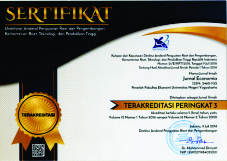Determinants of Service Quality and Continuance Intention to Use Online Reporting System
Downloads
Abstract: Determinants of Service Quality and Continuance Intention to Use Online Reporting System. This study aims to analyze the effect of perceived usefulness, perceived ease of use, convenience, and security towards service quality and continuance intention to use SIPP online at BPJS Employment. This study uses online survey method to 50 companies participating in BPJS Employment with Platinum and Gold segmentation. The online questionnaire was filled by the head of Human Resources Department. Data were analyzed using PLS-SEM. The results show that service quality was significantly influenced by perceived ease of use and convenience, while continuance intention to use SIPP online was only influenced by perceived usefulness.
Keywords: continuance intention, service quality, online reporting system
Abstrak: Faktor Penentu Kualitas Layanan dan Minat untuk Melanjutkan Penggunaan Sistem Pelaporan Online. Penelitian ini bertujuan untuk menganalisis pengaruh perceived usefulness, perceived ease of use, kenyamanan, dan keamanan terhadap kualitas layanan dan minat untuk melanjutkan menggunakan SIPP online di BPJS Ketenagakerjaan. Penelitian ini menggunakan metode survei online kepada 50 perusahaan peserta BPJS Ketenagakerjaan dengan segmentasi Platinum dan Gold. Kuesioner online diisi oleh Kepala Bagian Sumber Daya Manusia. Data dianalisis dengan menggunakan PLS-SEM. Penelitian ini menemukan bahwa kualitas layanan secara signifikan dipengaruhi oleh perceived ease of use dan kenyamanan, sedangkan minat melanjutkan penggunaan SIPP online hanya dipengaruhi oleh perceived usefulness.
Kata Kunci: minat melanjutkan penggunaan, kualitas layanan, sistem pelaporan online
Downloads
style='mso-element:field-begin;mso-field-lock:yes'>ADDIN Mendeley
Bibliography CSL_BIBLIOGRAPHY <![endif]-->Ahuja, M., Gupta, B., & Raman, P. (2003). An Empirical Investigation of Online Consumer Purchasing Behavior. Communications of the ACM, 46(12), 145. http://doi.org/10.1145/953460.953494
Akter, S., Ray, P., & D'Ambra, J. (2013). Continuance of mHealth services at the bottom of the pyramid: the roles of service quality and trust. Electronic Markets, 23(1), 29–47. http://doi.org/10.1007/s12525-012-0091-5
Ambali, A. R., & Bakar, A. N. (2014). ICT Adoption and Application in the Malaysian Public Sector. Hershey: IGI Publishing.
Berry, L. L., Seiders, K., & Grewal, D. (2002). Understanding Service Convenience. Journal of Marketing, 66(3), 1–17.
Bhattacherjee, A. (2001). Understanding Information Systems Continuance: An Expectation-Confirmation Model. MIS Quarterly, 25(3), 351–370.
Bhattacherjee, A., & Premkumar, G. (2004). Understanding Changes in Belief and Attitude toward Information Technology Usage: A Theoretical Model and Longitudinal Test. MIS Quarterly, 28(2), 229–254.
BPJS Ketenagakerjaan. (2016). Sistem Informasi Jaminan Sosial Tenaga Kerja (SIJSTK). Jakarta.
Chang, M.-Y., Chen, K., Pang, C., Chen, C.-M., & Yen, D. C. (2013). A study on the effects of service convenience and service quality on maintenance revisit intentions. Computer Standards and Interfaces, 35, 187–194. http://doi.org/10.1016/j.csi.2012.08.002
Collier, J. E., & Kimes, S. E. (2012). Only If It Is Convenient: Understanding How Convenience Influences Self-Service Technology Evaluation. Journal of Service Research, 16(1), 39–51. http://doi.org/10.1177/1094670512458454
Curran, J. M., & Meuter, M. L. (2005). Self"service technology adoption: comparing three technologies. Journal of Services Marketing, 19(2), 103–113.
Davis, F. D. (1985). A technology acceptance model for empirically testing new end-user information systems: Theory and results. Management.
Hair, J. F., Ringle, C. M., & Sarstedt, M. (2011). PLS-SEM: Indeed a Silver Bullet. The Journal of Marketing Theory and Practice, 19(2), 139–152. http://doi.org/10.2753/MTP1069-6679190202
He, G., & Jun, L. (2010). Study of the Relationship Between Service Quality, Customer Satisfaction and Behavior Intention. In International Conference on E-Product E-Service and E-Entertainment (ICEEE ) (pp. 1–4). Henan, China: IEEE.
Hidayat-ur-rehman, I., Mokhtar, S. A., & Katan, H. (2016). An Empirical Analysis of Consumers' Continuance Intention Towards Online Shopping. Mediterranean Journal of Social Sciences, 7(5), 95–104. http://doi.org/10.5901/mjss.2016.v7n5p95
Hou, C.-K. (2015). Understanding Business Intelligence System Continuance Intention: An Empirical Study of Taiwan's Electronics Industry. Information Development, 1–13. http://doi.org/10.1177/0266666915599588
Hu, P. J., Brown, S. A., Thong, J. Y. L., Chan, F. K. Y., & Tam, K. Y. (2009). Determinants of Service Quality and Continuance Intention of Online Services: The Case of eTax. Journal of American Society for Information Science and Technology, 60(2), 292–306. http://doi.org/10.1002/asi
Huayong, D., Mian, Z., Kaijun, L., & Jinbo, C. (2016). Examining the Role of Inhibitors in Customer Intention to Continue Using Mobile Services: An IS Success Theory Perspective. Recent Patents on Computer Science, 9(3).
Jarvenpaa, S. L., & Todd, P. A. (1996). Consumer Reactions to Electronic Shopping on the World Wide Web. International Journal of Electronic Commerce, 1(2), 59–88.
Jiang, X., & Ji, S. (2014). E-Government web portal adoption: A service level and service quality perspective. In Proceedings of the Annual Hawaii International Conference on System Sciences (pp. 2179–2188). IEEE. http://doi.org/10.1109/HICSS.2014.275
Lee, H. M., & Chen, T. (2014). Perceived quality as a key antecedent in continuance intention on mobile. International Journal of Electronic Commerce Studies, 5(2), 123–142. http://doi.org/10.7903/ijecs.1150
Lin, Z., & Filieri, R. (2015). Airline passengers' continuance intention towards online check-in services: The role of personal innovativeness and subjective knowledge. Transportation Research Part E, 81, 158–168. http://doi.org/10.1016/j.tre.2015.07.001
Miyazaki, A. D., & Fernandez, A. (2001). Consumer Perceptions of Privacy and Security Risks for Online Shopping. The Journal of Consumer Affairs, 35(1), 27–44.
Parasuraman, A., Zeithaml, V. A., & Berry, L. L. (1988). SERVQUAL: A Multiple-Item Scale for Measuring Consumer Perceptions of Service Quality. Journal of Retailing, 64(1), 12–40.
Pikkarainen, T., Pikkarainen, K., Karjaluoto, H., & Pahnila, S. (2004). Consumer acceptance of online banking: an extension of the technology acceptance model. Internet Research, 14(3), 224–235. http://doi.org/https://doi.org/10.1108/10662240410542652
Rai, A., Lang, S. S., & Welker, R. B. (2002). Assessing the Validity of IS Success Models: An Empirical Test and Theoretical Analysis. Information Systems Research, 13(1), 50–69.
Susanto, A., Chang, Y., & Ha, Y. (2016). Determinants of continuance intention to use the smartphone banking services. Industrial Management & Data Systems, 116(3), 508–525.
Torkzadeh, G., & Dhillon, G. (2002). Measuring factors that influence the success of Internet commerce. Information Systems Research, 13(2), 187–204. http://doi.org/10.1287/isre.13.2.187.87
Venkatesh, V., Morris, M. G., Davis, G. B., & Davis, F. D. (2003). User Acceptance of Information Technology: Toward a Unified View. MIS Quarterly, 27(3), 425–478.
Vijayasarathy, L. R. (2004). Predicting consumer intentions to use on-line shopping: the case for an augmented technology acceptance model. Information & Management 41, 41, 747–762. http://doi.org/10.1016/j.im.2003.08.011
Wangpipatwong, S., Chutimaskul, W., & Papasratorn, B. (2008). Understanding Citizen's Continuance Intention to Use e-Government Website: a Composite View of Technology Acceptance Model. The Electronic Journal of E-Government, 6(1), 55–64.
Wu, X., Chen, Q., Sheng, L., & Wang, Y. (2009). A conceptual model of m-commerce customers' continuance intention based on the customers' perceived value. International Journal of Mobile Learning and Organisation, 3(3), 243–257. http://doi.org/10.1504/IJMLO.2009.026311
Yang, K., Liang, H., & Wang, B. (2010). Studies on the Factors of Interaction Quality in Public Service Quality Management. In International Conference on Management and Service Science (MASS 2010). Wuhan, China: IEEE.
Yuan, S., Liu, Y., Yao, R., & Liu, J. (2014). An investigation of users' continuance intention towards mobile banking in China. Information Development, 1–15. http://doi.org/10.1177/0266666914522140
Zeithaml, V. A., Berry, L. L., & Parasuraman, A. (1996). The behavioral consequences of service quality. Journal of Marketing, 60, 31–46.
Zeithaml, V. A., Parasuraman, A., & Malhotra, A. (2002). Service Quality Delivery through Web Sites: A Critical Review of Extant Knowledge. Journal of the Academy of Marketing Science, 30(4), 362–375.
Zhang, X., & Prybutok, V. (2005). A Consumer Perspective of E-Service Quality. IEEE Transactions on Engineering Management, 52(4), 461–477.
Zhao, L., Lu, Y., Zhang, L., & Chau, P. Y. K. (2012). Assessing the effects of service quality and justice on customer satisfaction and the continuance intention of mobile value-added services: An empirical test of a multidimensional model. Decision Support Systems, 52, 645–656. http://doi.org/10.1016/j.dss.2011.10.022
style='font-size:12.0pt;line-height:120%;font-family:"Calibri",sans-serif;
mso-fareast-font-family:Calibri;mso-bidi-font-family:"Times New Roman";
mso-ansi-language:EN-US;mso-fareast-language:EN-US;mso-bidi-language:AR-SA'>
style='mso-element:field-end'><![endif]-->















